Cite this document
(“Web security Essay Example | Topics and Well Written Essays - 3250 words”, n.d.)
Web security Essay Example | Topics and Well Written Essays - 3250 words. Retrieved from https://studentshare.org/information-technology/1617922-web-security
Web security Essay Example | Topics and Well Written Essays - 3250 words. Retrieved from https://studentshare.org/information-technology/1617922-web-security
(Web Security Essay Example | Topics and Well Written Essays - 3250 Words)
Web Security Essay Example | Topics and Well Written Essays - 3250 Words. https://studentshare.org/information-technology/1617922-web-security.
Web Security Essay Example | Topics and Well Written Essays - 3250 Words. https://studentshare.org/information-technology/1617922-web-security.
“Web Security Essay Example | Topics and Well Written Essays - 3250 Words”, n.d. https://studentshare.org/information-technology/1617922-web-security.


